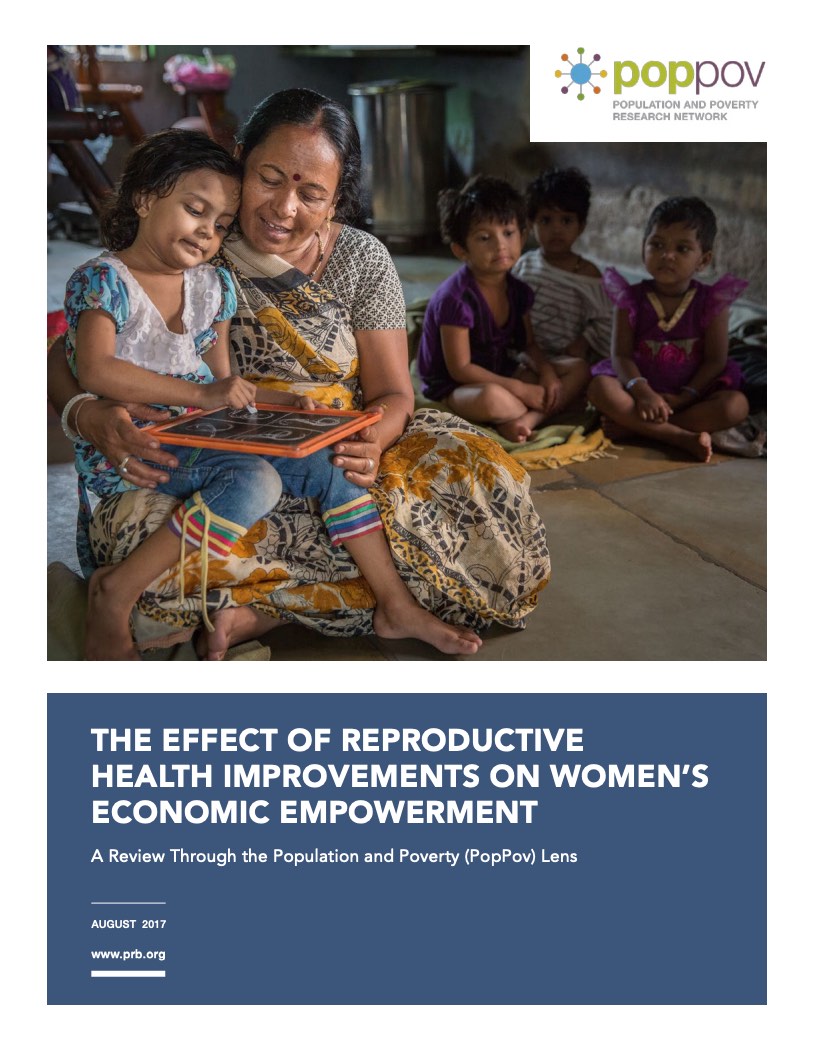
The Effect of Reproductive Health Improvements on Women's Economic Empowerment
Date
September 6, 2017
Authors
Marlene Lee
Associate Vice President
Jocelyn E. Finlay
Research Scientist at the Department of Global Health and Population of the Harvard T. H. Chan School of Public Health
Women’s access to employment, business opportunities, and financial resources are widely seen as critical to achieving the United Nations Sustainable Development Goals (SDGs) over the next 15 years. With increased attention to women’s economic empowerment among donors and policymakers across the globe, we are at a pivotal moment for reviewing the current state of the research on women’s economic empowerment to identify gaps.
This report reviews the Population and Poverty (PopPov) Research Network’s most rigorous results from the past 10 years with attention to the effect of reproductive health improvements on women’s economic empowerment. We also draw on results generated outside the network over the same time period, provided that they address this causal relationship and use rigorous statistical methods.
As an initial step, the report reviews the evolving definition of women’s empowerment, drawing in particular on the International Center for Research on Women (ICRW) definition of economic empowerment. This definition is particularly relevant to the Population and Poverty (PopPov) Research Initiative objectives:
“A woman is economically empowered when she has
- (1) the ability to succeed and advance economically, and
- (2) the power to make and act on economic decisions.”1
Consistent with this definition, the organization also proposes specific measures of economic empowerment at the individual, household, and community levels, which are present in PopPov and other research on women’s economic empowerment. ICRW separates the measurement instruments for women’s economic empowerment into three categories: reach and process indicators (participation); economic advancement indicators (skills, income, work environment); and power and agency indicators (decisionmaking, autonomy, self-confidence).2 ICRW also suggests a range of survey questions at the individual, community, and national levels to collect the necessary data.
Our review of findings revealed:
- Improvements in reproductive health do lead to improvements in women’s economic empowerment.
- Expanding contraceptive use improves women’s agency, education, and labor force participation.
- Higher maternal age at first birth (reducing adolescent childbearing) increases the likelihood of school completion and participation in the formal labor market.
- Longer birth intervals increase labor market participation, as does having fewer children.
Gaps remain, however, in measuring women’s work and in the full exploration of women’s economic empowerment. Despite these gaps, several specific findings already suggest directions for policy action to increase women’s economic empowerment:
- Increase access to and use of contraceptives and quality family planning services. Unmet need for family planning and low contraceptive use in many (African) countries keep women from achieving their desired family size and also limit women’s economic advancement.
- Expose the colonial roots of restrictive laws that institutionalize incentives for low contraceptive use, increasing the risk of unplanned pregnancies. In Africa, the colonial legacy of the stricter laws in French colonies governing contraceptives, as compared to British colonies, resonates today in lower contraceptive use and higher fertility despite liberalizations in the laws since independence in the 1960s.
- Attack barriers to contraceptive uptake other than cost. In the developing-country context, the cost of contraception is not a major barrier to uptake of contraception.3 Family planning policies that address other barriers to uptake, such as availability or cost of transportation, are more effective in increasing contraceptive use. Many of these costs that impede uptake must be overcome even before individuals consider the price of contraceptives.
- Provide information services and couples communication training to promote agency for women and couples. Most measures of empowerment include considerations of employment and agency. For this reason, informed decisionmaking (one measure of agency) is a key component of economic empowerment; the measure of work in itself does not signal empowerment. Women may work because they are forced to, and some may not work because they choose not to. In the sub- Saharan African context, an additional child means that a woman is 6 percent less likely to work, and that impact is particularly strong for older, educated women. This finding suggests that women who are likely more informed by experience and education choose not to work. But it is unclear whether these women have information about family planning and if they have the power to influence men’s fertility preferences. This finding, in conjunction with results on household decisionmaking, calls into question the use of labor force participation as a measure of female economic empowerment. It also raises the issue of whether a composite measure of empowerment is needed. Informed women who decide to have more children and to work more have agency and economic participation.
- Consider how cultural norms mitigate positive effects. For individuals who move against cultural norms such as early marriage, the long-term outcomes can have a negative effect on their overall empowerment. Also, in contexts where contraceptive use has not been accepted as the norm, all women do not benefit equally from their use.
References
- William and Flora Hewlett Foundation,Women’s Economic Empowerment Strategy (Menlo Park, CA: William and Flora Hewlett Foundation, 2015).
- Anne Marie Golla et al., Understanding and Measuring Women’s Economic Empowerment: Definition, Framework, and Indicators (Washington, DC: International Center for Research on Women (ICRW), 2011).
- Mahesh Karra, presentation made at World Health Organization (WHO) Technical Meeting, Financing Family Planning, Washington, DC, 2014.

 ">
">